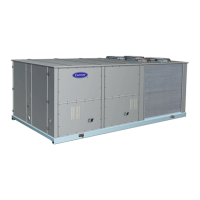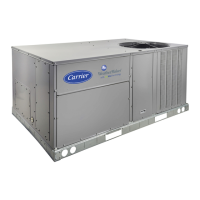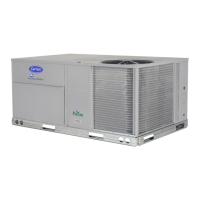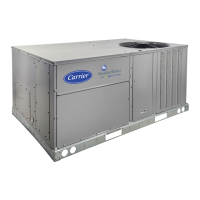53
HT.CF = 3 (Staged Gas Heating Control)
As an option, the units with gas heat can be equipped with
staged gas heat controls that will provide from 5 to 11 stages of
heat capacity. This is intended for tempering mode and temper-
ing economizer air when in a cooling mode and the dampers
are fully closed. Tempering can also be used during a pre-occu-
pancy purge to prevent low temperature air from being deliv-
ered to the space. Tempering for staged gas will be discussed in
its own section. This section will focus on heat mode control,
which ultimately is relevant to tempering, minus the consider-
ation of the supply air heating control point.
The staged gas configurations are located at the local display
under Configuration
HEAT
SG.CF. See Table 52.
Staged Gas Heat Type (HT.ST)
This configuration sets the number of stages and the order that
are they staged.
Max Cap Change per Cycle (CAP.M)
This configuration limits the maximum change in capacity per
PID run time cycle.
S.Gas DB Min.dF/PID Rate (M.R.DB)
This configuration is a deadband minimum temperature per
second rate. See Staged Gas Heating logic below for more de-
tails.
St.Gas Temp.Dead Band (S.G.DB)
This configuration is a deadband delta temperature. See Staged
Gas Heating Logic below for more details.
Heat Rise in dF/Sec Clamp (RISE)
This configuration prevents the heat from staging up when the
leaving-air temperature is rising too fast.
LAT Limit Config (LAT.L)
This configuration senses when leaving-air temperature is out-
side a delta temperature band around setpoint and allows stag-
ing to react quicker.
Limit Switch Monitoring? (LIM.M)
This configuration allows the operation of the limit switch
monitoring routine. This should be set to NO as a limit switch
temperature sensor is not used with A Series units.
Limit Switch High Temp (SW.H.T)
This configuration is the temperature limit above which stages
of heat will be removed.
Limit Switch Low Temp (SW.L.T)
This configuration is the temperature limit above which no ad-
ditional stages of heat will be allowed.
Heat Control Prop. Gain (HT.P)
This configuration is the proportional term for the PID which
runs in the HVAC mode LOW HEAT.
Heat Control Derv. Gain (HT.D)
This configuration is the derivative term for the PID which
runs in the HVAC mode LOW HEAT.
Heat PID Rate Config (HT.TM)
This configuration is the PID run time rate.
Staged Gas Heating Logic
If the HVAC mode is HIGH HEAT:
• The supply fan for staged gas heating is controlled by the
integrated gas control (IGC) boards and, unless the supply
fan is on for a different reason, it will be controlled by the
IGC indoor fan input.
• Command all stages of heat ON.
If the HVAC mode is LOW HEAT:
• The supply fan for staged gas heating is controlled by the
integrated gas control (IGC) boards and, unless the supply
fan is on for a different reason, it will be controlled by the
IGC indoor fan input.
• The unit will control stages of heat to the heating control
point (Run Status
VIEW
HT.C.P). The heating con-
trol point in a LOW HEAT HVAC mode for staged gas is
the heating supply air setpoint (Setpoints
SA.HT).
Staged Gas Heating PID Logic
The heat control loop is a PID (proportional/integral/deriva-
tive) design with exceptions, overrides, and clamps. Capacity
rises and falls based on setpoint and supply-air temperature.
When the staged gas control is in Low Heat or Tempering
Mode (HVAC mode), the algorithm calculates the desired heat
capacity.
The basic factors that govern the controlling method are:
• how fast the algorithm is run.
• the amount of proportional and derivative gain applied.
• the maximum allowed capacity change each time this al-
gorithm is run.
• deadband hold-off range when rate is low.
This routine is run once every HT.TM seconds. Every time the
routine is run, the calculated sum is added to the control output
value. In this manner, integral effect is achieved. Every time
this algorithm is run, the following calculation is performed:
Error = HT.C.P – LAT
Error_last = error calculated previous time
P = HT.P*(Error)
D = HT.D*(Error - Error_last)
The P and D terms are overridden to zero if:
Error < S.G.DB AND Error > - S.G.DB AND D < M.R.DB AND
D > - M.R.DB. “P + D” are then clamped based on CAP.M. This
sum can be no larger or no smaller than +CAP.M or –CAP.M.
Table 52 — Staged Gas Configuration
*Some configurations are model number dependent.
ITEM EXPANSION RANGE UNITS CCN POINT DEFAULTS
SG.CF STAGED GAS CONFIGS
HT.ST Staged Gas Heat Type 0 to 4 HTSTGTYP 0*
CAP.M Max Cap Change per Cycle 5 to 45 HTCAPMAX 45*
M.R.DB S.Gas DB min.dF/PID Rate 0 to 5 HT_MR_DB 0.5
S.G.DB St.Gas Temp. Dead Band 0 to 5 ^F HT_SG_DB 2
RISE Heat Rise dF/sec Clamp 0.05 to 0.2 HTSGRISE 0.06
LAT.L LAT Limit Config 0 to 20 ^F HTLATLIM 10
LIM.M Limit Switch Monitoring? Yes/No HTLIMMON Yes
SW.H.T Limit Switch High Temp 110 to 180 dF HT_LIMHI 170*
SW.L.T Limit Switch Low Temp 100 to 170 dF HT_LIMLO 160*
HT.P Heat Control Prop. Gain 0 to 1.5 HT_PGAIN 1
HT.D Heat Control Derv. Gain 0 to 1.5 HT_DGAIN 1
HT.TM Heat PID Rate Config 60 to 300 sec HTSGPIDR 90

